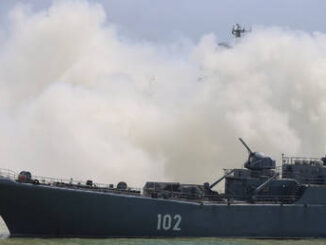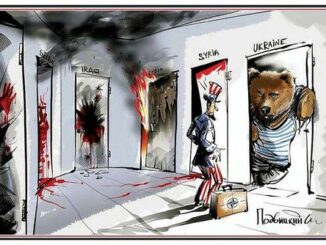
Against all odds, Ukrainians have been dominating Russia in the Black Sea.
ODESA, Ukraine—In his office overlooking Odesa’s Pivdennyi Port on the Black Sea, Viktor Berestenko smiled contentedly at the half-dozen large international cargo ships just beyond the harbor. “It’s as beautiful as your first kiss,” said the grinning president of the Association of International Freight Forwarders of Ukraine. Speaking to Foreign Policy in late March Berestenko was only too happy to inform me that Ukraine’s three free ports—all in and around Odesa—are operating 24/7, and that the country’s grain exports are back to prewar levels.
The restoration of Black Sea trade is a major breakthrough for Ukraine, in stark contrast to the losses it has endured this year on the eastern fronts. In the Black Sea theater, Ukraine has pulled off the unthinkable: beating back the esteemed Russian Navy even though it has next to no naval force of its own.
From the tiny swath of coastline around Odesa, Ukraine has stymied Moscow’s attempt to landlock and hobble its economy by rendering it unable to market its voluminous agricultural exports. In the spring of 2022, the Russian military barricaded Ukraine’s Black Sea ports and brought exports to a standstill. This forced Ukraine to shift to land routes to market its goods and caused worldwide grain prices to spike, which raised concerns about famine in the Middle East and Africa. Today, Russia still occupies 16 Ukrainian ports. But the Black Sea front looks more hopeful for Ukraine than at any time since the war’s onset more than two years ago.
The Ukrainian fleet lost 80 percent of its vessels after the Russian occupation of Crimea in 2014. But, relying a combination of missile systems and unmanned drone boats guided by advanced GPS and cameras, Ukraine’s armed forces claim to have crippled a third of Russia’s Black Sea fleet. They have also upended the Russian supply lines that serve thousands of troops in the occupied areas of southern Ukraine.
On March 24, Ukraine landed another blow, reportedly using U.K.- or French-made air-to-surface missiles, taking out two large Russian landing ships and other infrastructure near the occupied Crimean port city of Sevastopol. Russia’s fleet has suffered such a drubbing that it prompted the firing of its top admiral, Nikolai Yevmenov, in mid-March. Today, Russia’s remaining ships are in docked in berths along the far side of the Crimean Peninsula, out of sight but not entirely out of Ukraine’s reach.
“Russia wanted to turn the Black Sea into a big Russian lake. But Ukraine reversed it,” said Volodymyr Dubovyk, the director of the Center for International Studies at the Odesa Mechnikov National University. “Russian ships today don’t venture into the northwest of the Black Sea.”
This cover has enabled Ukraine to improvise a sea corridor that begins in Odesa and hugs the safe shores of NATO members Romania, Bulgaria, and Turkey as ships travel southwest en route to the Bosphorus Strait, through which most Black Sea trade passes. Exploiting a bumper crop, Ukraine is now exporting as much grain—corn, wheat, and barley—as it did before the war, as well as other goods, and has opened its Odesan ports for nighttime business to handle yet more. Prior to the war, Ukraine traded more grain than the entire European Union and supplied half of the globally traded sunflower oil, as well as iron ore and fertilizer, according to Bloomberg.
“This is enormously important for Ukraine’s economy, for the Odesa region, and for our future,” said Sergey Yakubovskiy, an economist at Odesa National University. “We have to do everything to keep this route open and reliable.”
Ukraine’s asymmetric Black Sea strategy relies ever more upon Ukraine-made drone boats—known as uncrewed surface vessels (USVs)—that speed across the water beneath Russian radar carrying up to 800 kilograms (1,760 pounds) of explosives. These projectiles have sunk or disabled some of the 24 lost Russian warships, evidence that Ukraine’s domestic arms production has been stepped up and is increasingly consequential in the absence of anticipated U.S. and European assistance. According to the Guardian, there are currently 200 drone manufacturing companies in Ukraine, some of them bankrolled by crowdfunding campaigns. In December 2023, they delivered 50 times as many robotic explosives as in the entire year of 2022, according to Ukraine’s Ministry of Digital Transformation.
Ukraine’s strategy is to maintain its presence in the Black Sea with the prospect of soon acquiring the longer-range missiles that it needs to hit Crimea itself and Russia proper beyond it, Dubovyk said. For Ukraine, he explained, the pressing issue is what comes next. “Crimea is in play, and if Ukraine can put more pressure on Russia there, it can make the occupation untenable. It would change the war’s logic if Russia couldn’t supply the eastern fronts from Crimea,” he said.
Russia’s response has been to target Odesa’s ports, energy infrastructure, and housing blocks with ballistic missiles. Seldom does a day pass without air raid sirens in the port city, which send its residents scrambling into their cellars. In March alone, Russian attacks killed 32 civilians.
One would think that the new coastal sea route would obviate Ukraine’s need to access EU markets via land, namely through Central Europe, and thus ameliorate the friction it has caused between the Central Europeans and Ukraine. Following Russia’s invasion, the EU allowed Ukraine tariff-free access to its markets, which had the effect of undermining the Visegrad Group states’ own grain trade and prompting farmers to take to the streets in anger, above all in Poland. Now, logically, trade could revert to its previous routes and the injurious tiff come to an end.
Not so quickly, explained Yakubovskiy, the economist. He pointed out that Ukraine’s new sea corridor is a temporary and unsanctioned byway, possible now only as a result of Russia’s naval weakness and an informal agreement between Russia and Ukraine not to target civilian shipping. It could end at any moment, he said.
As for Russia, it is not likely to improve its Black Sea positions soon. This is because Turkey controls the Bosphorus and Dardanelles straits, and Ankara has chosen to adhere to the letter of the 1936 Montreux Convention, which prohibits the passage of warships through the straights into the Black Sea in a time of war. Russia thus has no way of getting reinforcements to its ports.
The upshot of Russia’s retreat from Black Sea waters and Turkey’s control of the straits has put Ankara in the driver’s seat. Whether Ukraine maintains its new trade route thus depends, to some extent, on Turkey.
In the past, Ankara has shown itself deft at using leverage to promote its own interests, whatever they may be. It could turn Viktor Berestenko’s bliss into a short-lived fling.
Take the Survey at https://survey.energynewsbeat.com/
ENB Top News
ENB
Energy Dashboard
ENB Podcast
ENB Substack



